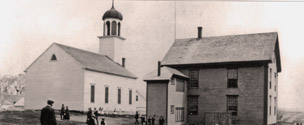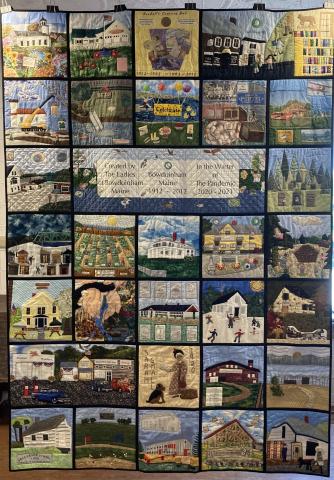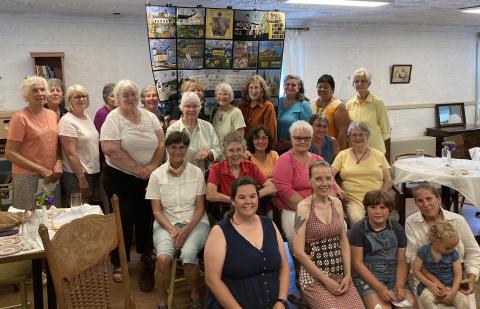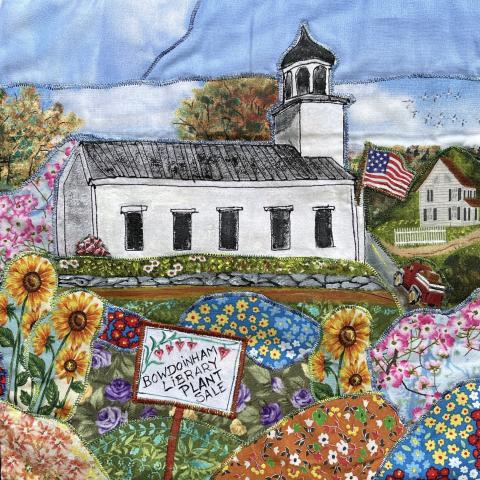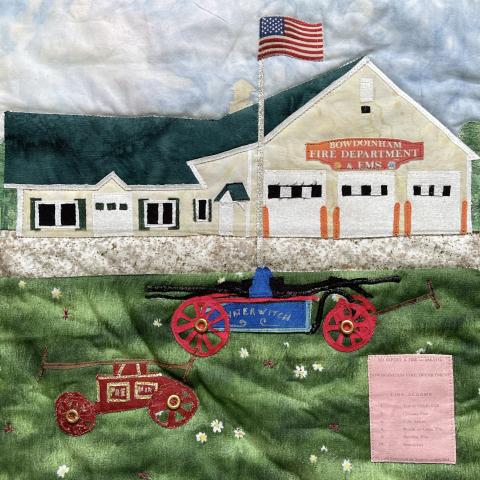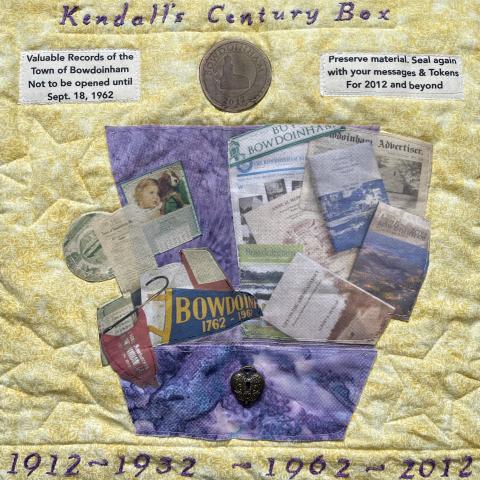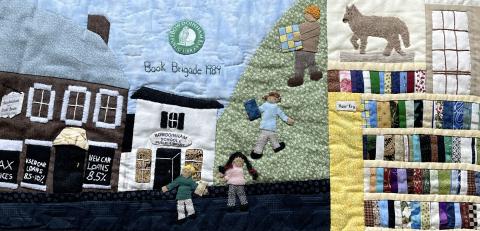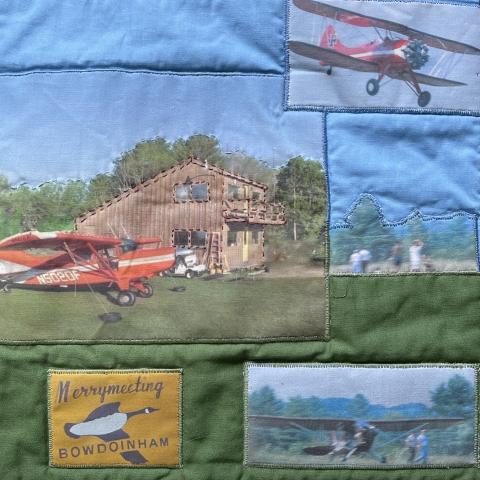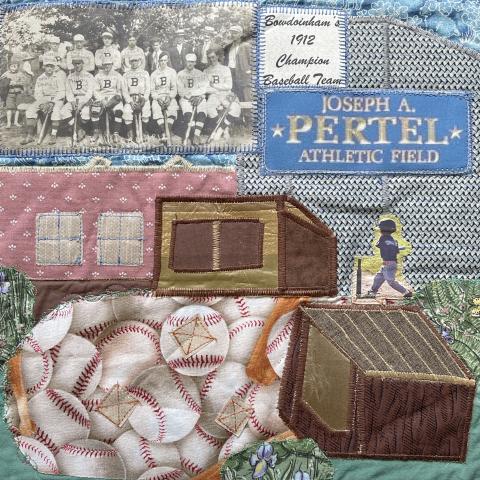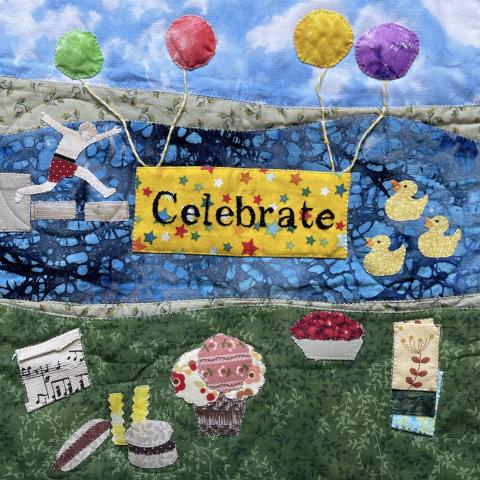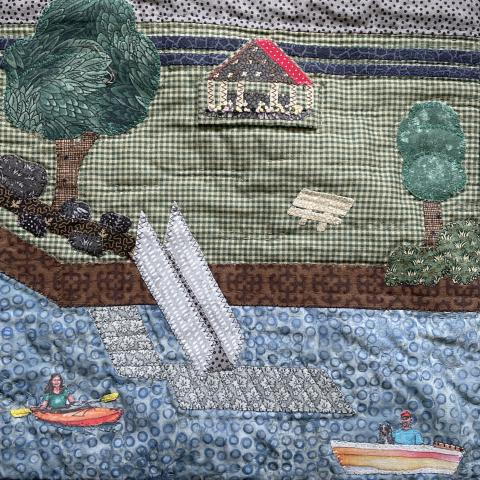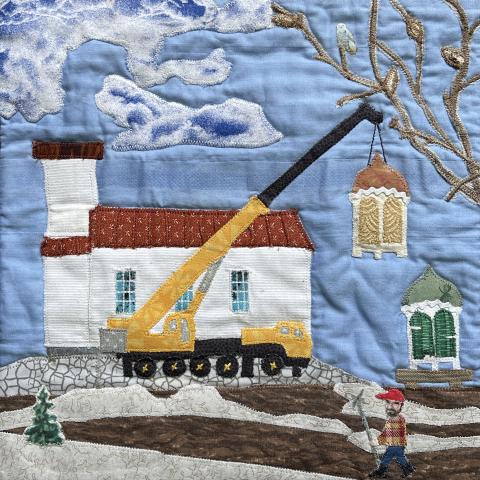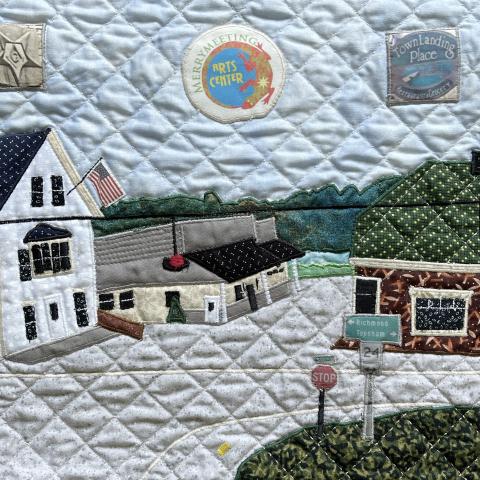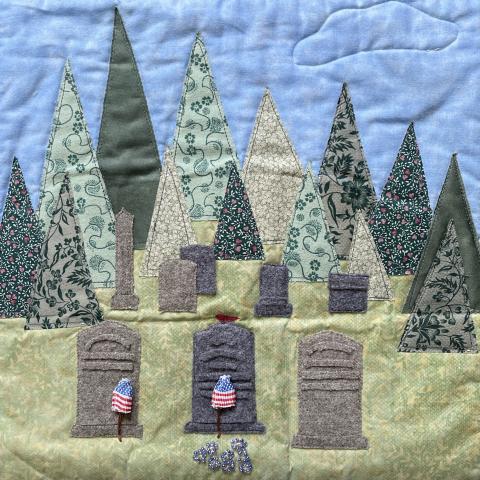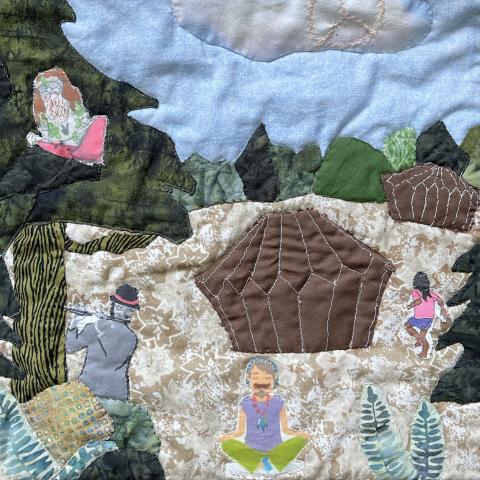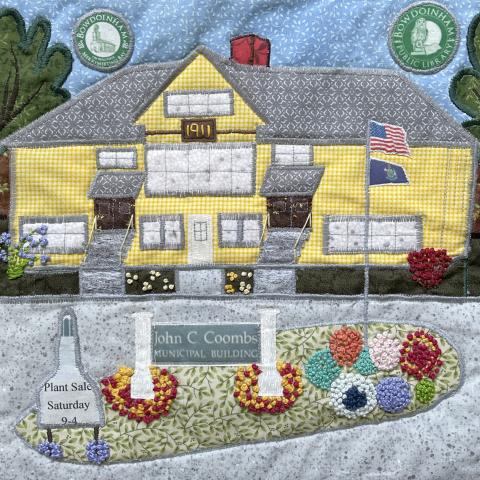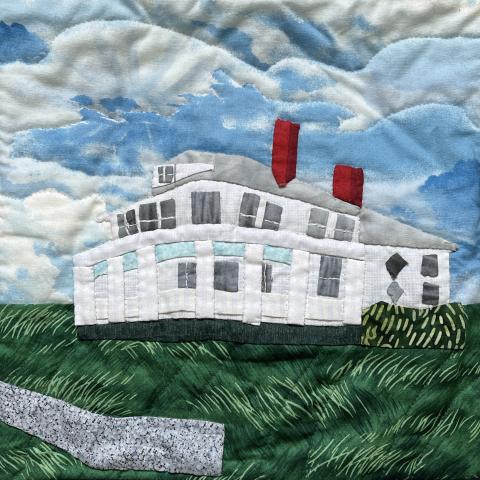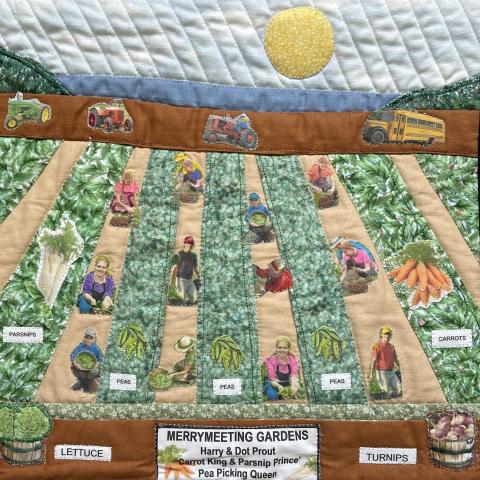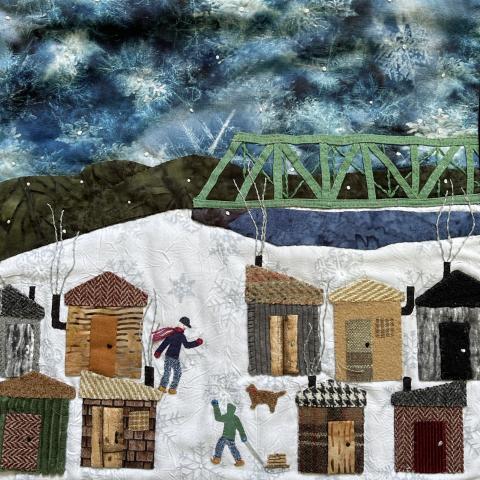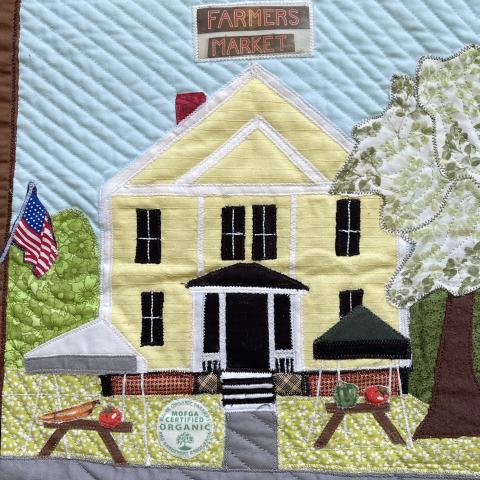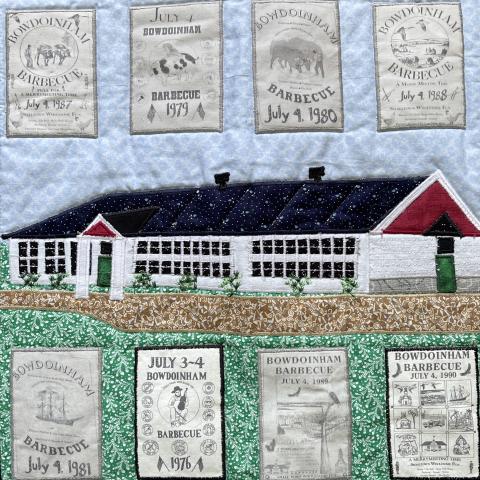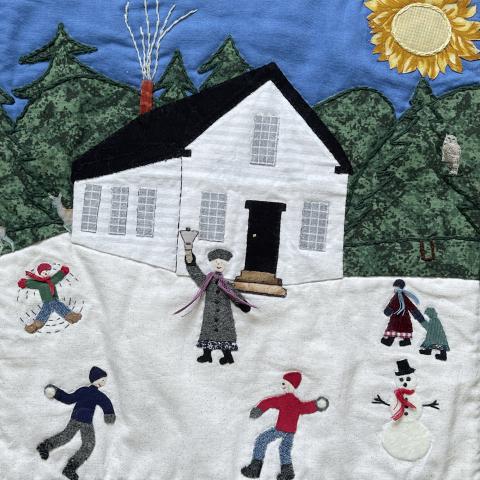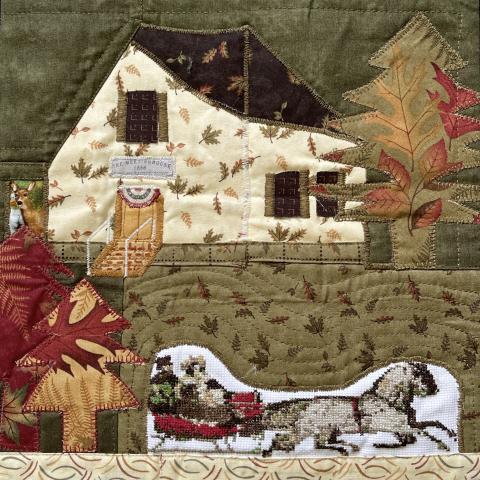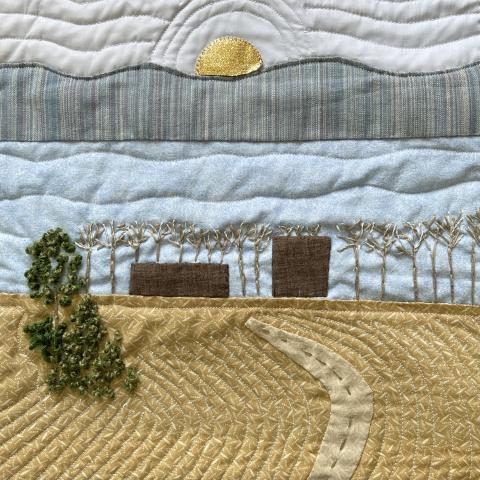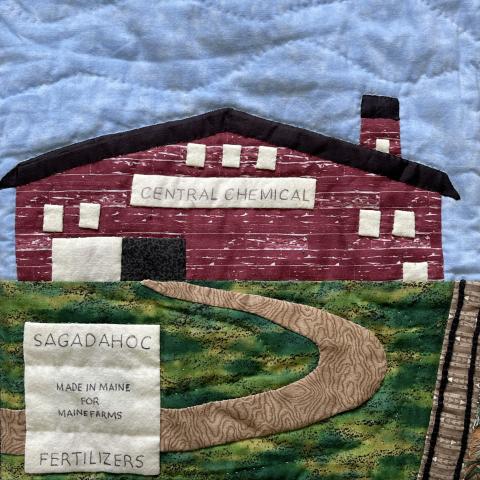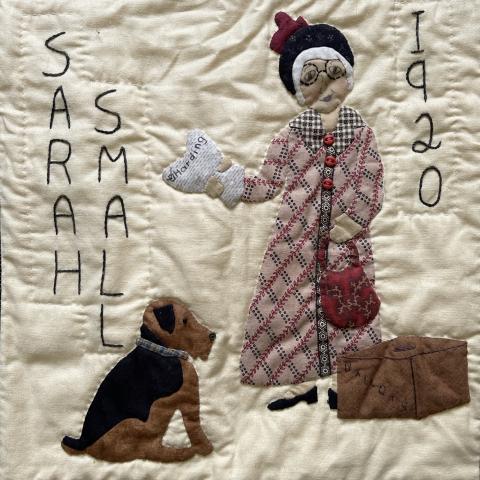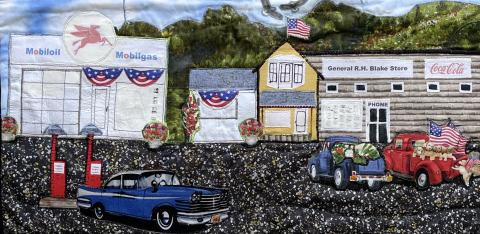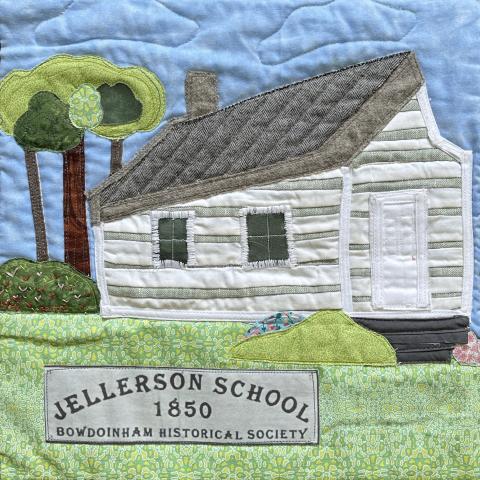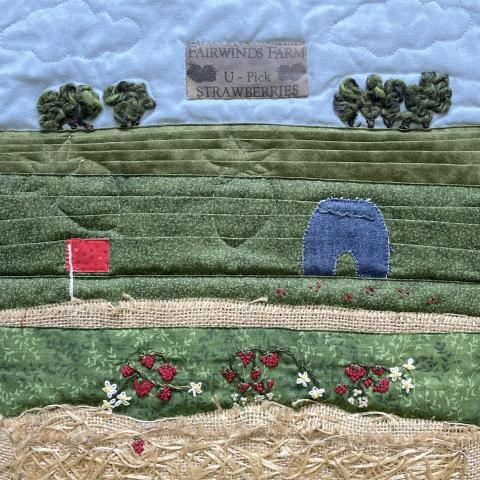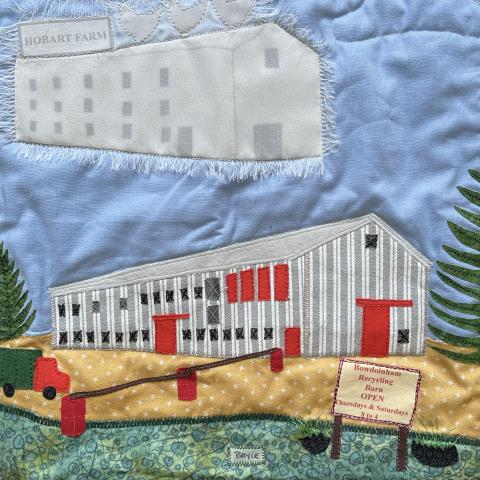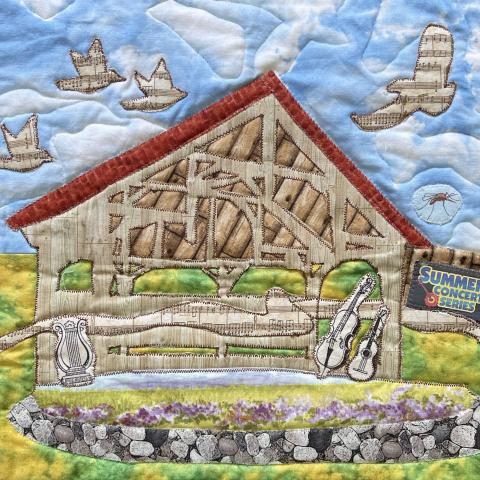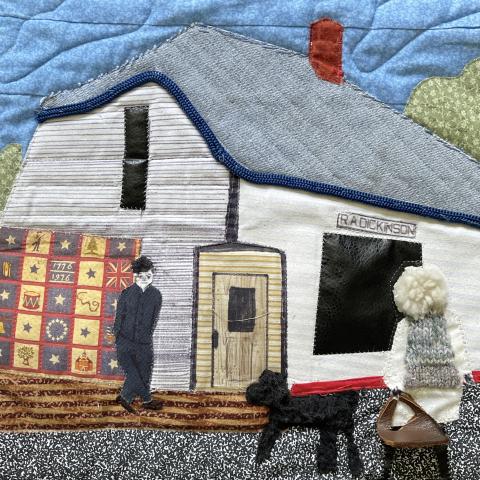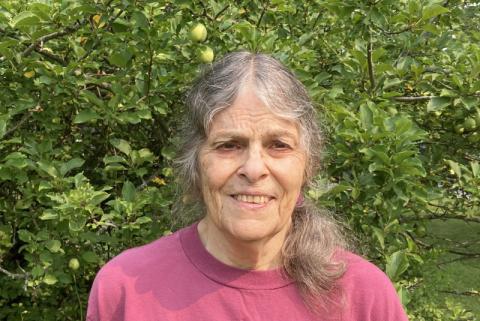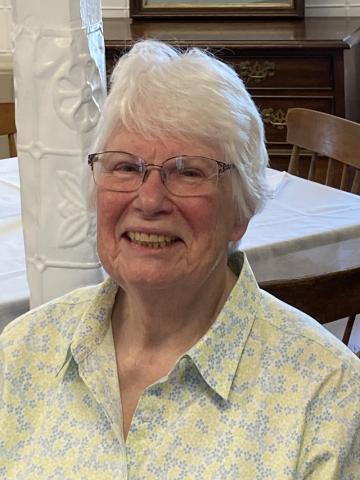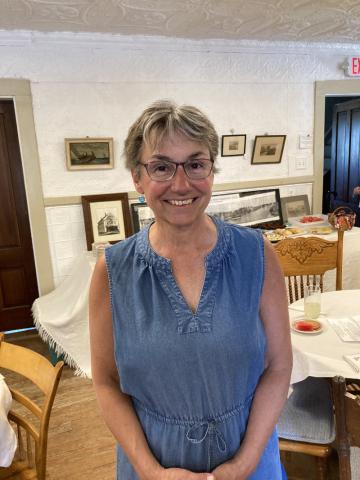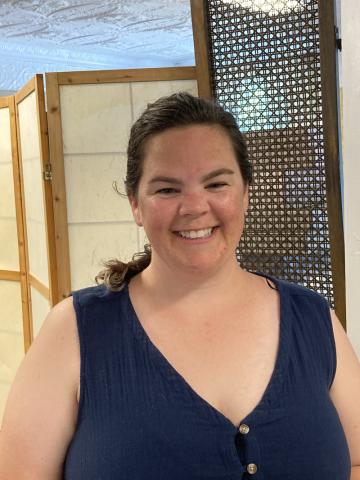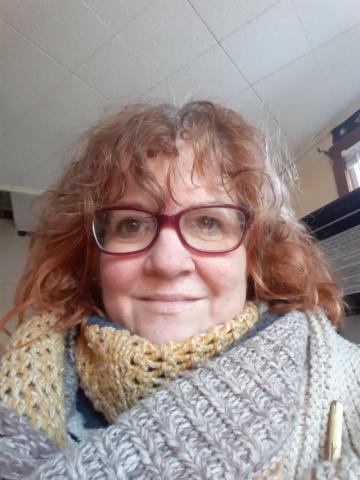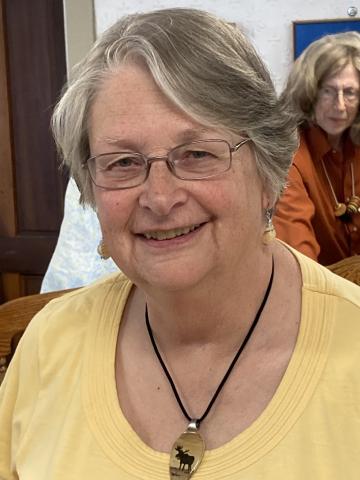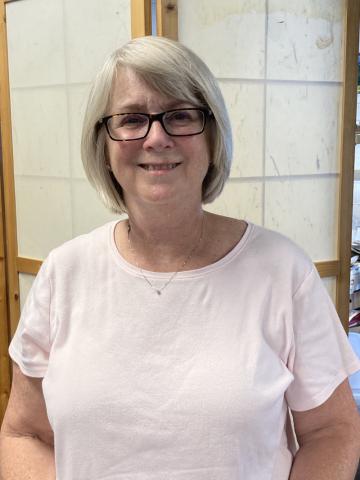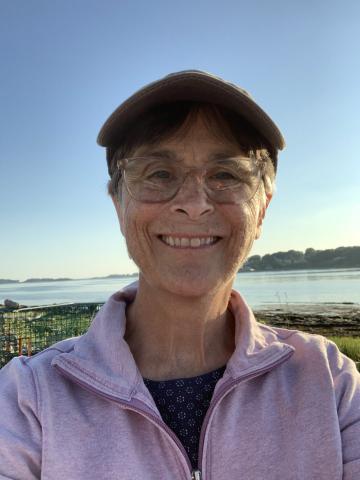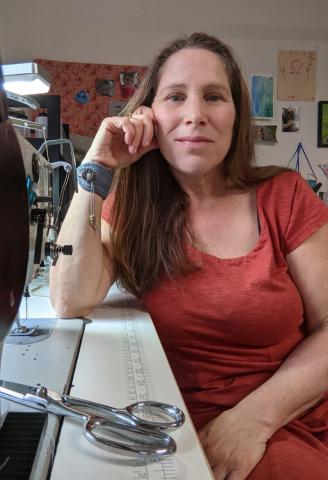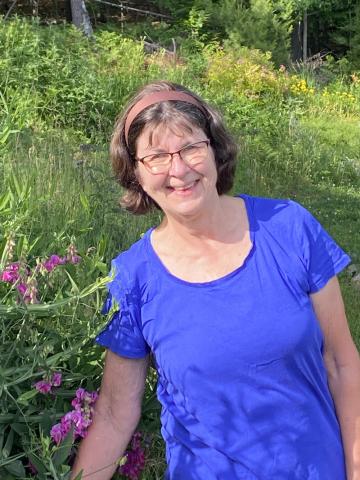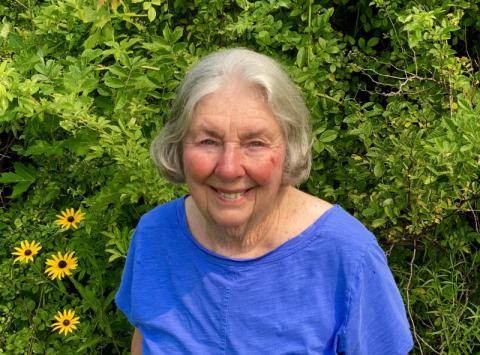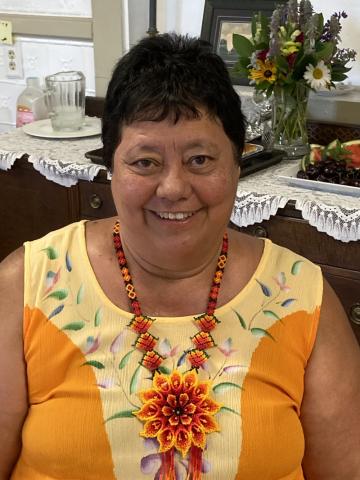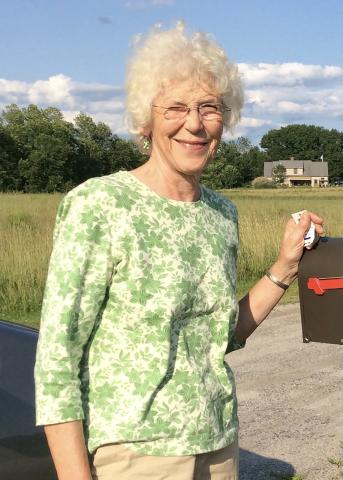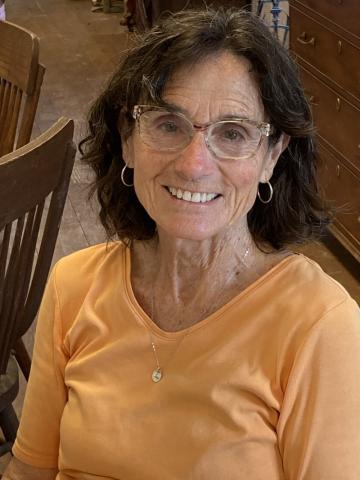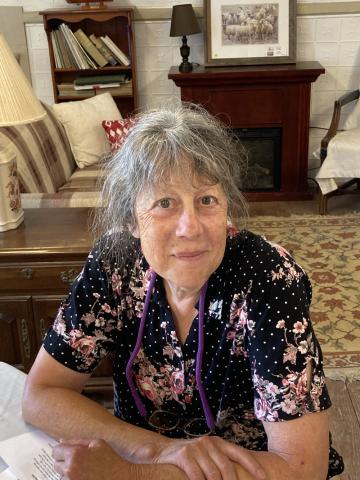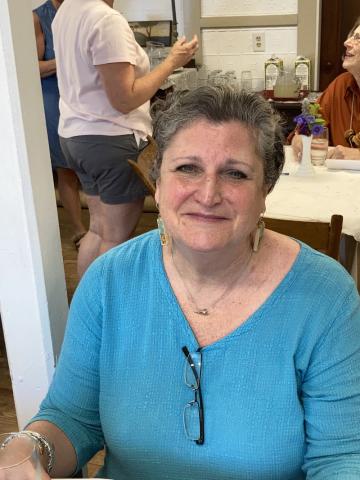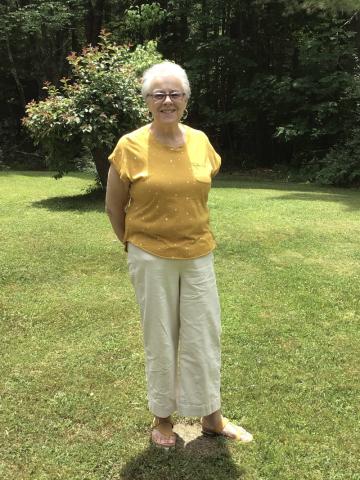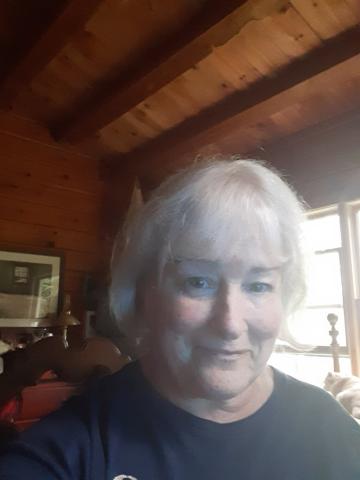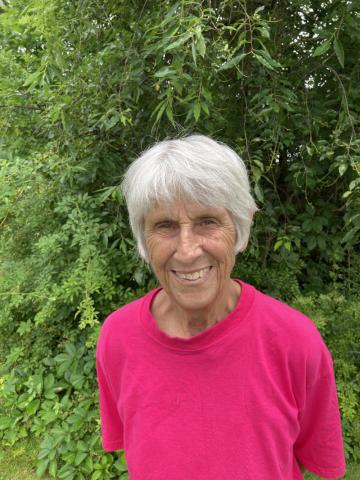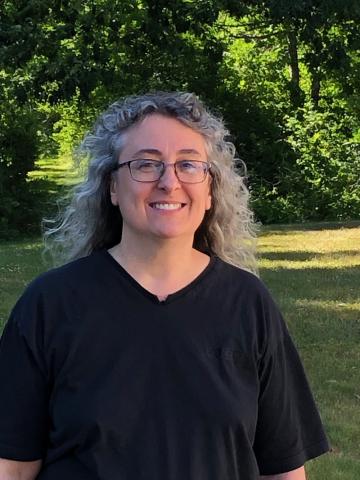Bowdoinham Quilt: 1912 to 2012
Don't miss the photo slide show at the bottom of the page.
Dedicated to the numerous and cheerfully willing volunteers in Bowdoinham, Maine
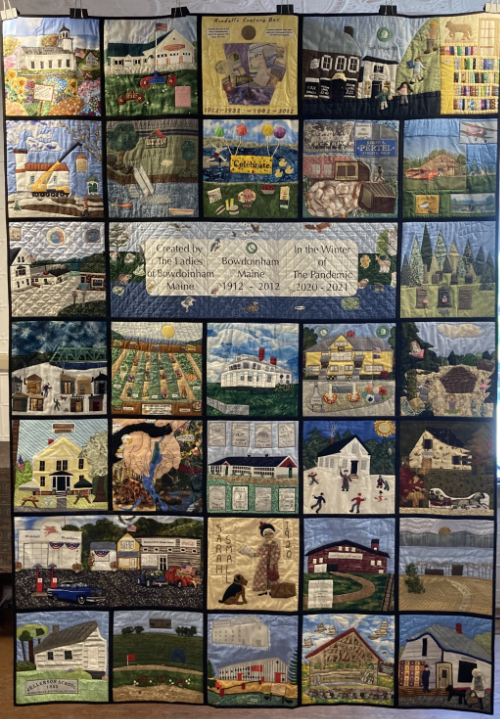 In Honor of All the Volunteers of Bowdoinham!
In Honor of All the Volunteers of Bowdoinham!
Bowdoinham has a LONG history of doing for itself, of folks volunteering their time, expertise, materials, and money to accomplish Town Goals. In this quilt, all created by volunteers, 18 of the 35 blocks represent buildings and activities for which volunteers have been a key. And this spirit of volunteering has been key to making Bowdoinham the Magical Town that it is.
The Story of the Quilt
The idea for this historical quilt of Bowdoinham 1912 to 2012 has been floating in and out of the heads of Nan Curtis and Betsy Steen since the last historical quilt, Bowdoinham 1762-1912, was created in 2012. Joanne Savoie asked if this might be a good time to do that quilt. On December 16, 2020, in the middle of a worldwide disaster, the Covid-19 Pandemic, when many of us were confined to home and isolated, these three ladies of Bowdoinham met via Zoom and the project to make this quilt was born! We pondered a theme, a “quilt as you go” design, how to find volunteers and get square ideas and most importantly, how to accomplish this safely during the Pandemic.
It was a tall order but we found 28 quilters, 1 designer, 35 square ideas, old fabrics for appliqué, enough fabric that matched the earlier quilt for the backing. We did it! Wanting to make it a social project, we added periodic Zoom meetings to learn new techniques and share our progress. We also used email, text and phone calls to answer questions and share ideas and keep in touch. We all enjoyed the occasional visits as they came up: “Pick Up” and “Drop Off” of supplies and Betsy’s labels, getting quilting advice from Nan. Even with masks and social distancing it was grand to see everyone.
The weeks passed, the quilters quilted, the labels of historical information were created, the snow slowed down, squares were completed and handed in, the quilters quilted, Nan trimmed each one and Bob, her husband, took photos of each, Spring arrived, we started putting the photos and labels on FaceBook: Bowdoinham Friends and Families and voila! the townspeople were onboard! Many of the squares brought back memories of days gone by and that generated much conversation on FaceBook about our town’s history.
On June 4th the final square came in, Nan put the entire quilt together almost overnight it seemed! On June 5th Lynn Sanford, Elaine Graviett and Joanne Savoie hand sewed the final binding edge. Presenting: The Historic, Commemorative Quilt of Bowdoinham 1912-2012 made by the Ladies of Bowdoinham during the Pandemic of 2020-2021!
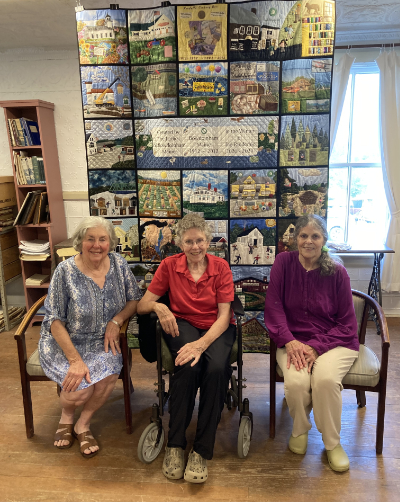 Although 30 people participated in creating the Pandemic Quilt, three women were responsible for leading the way. Joanne Savoie created 2 blocks, did all the organizing, communication, and publicity. Nan Curtis was the quilting expert providing advice, doing 2 plus blocks, much of the quilting, and finally assembling the quilt. Betsy Steen provided historic photos that guided the way to create scenes from long ago and wrote the back labels that tied the history to the quilt.
Although 30 people participated in creating the Pandemic Quilt, three women were responsible for leading the way. Joanne Savoie created 2 blocks, did all the organizing, communication, and publicity. Nan Curtis was the quilting expert providing advice, doing 2 plus blocks, much of the quilting, and finally assembling the quilt. Betsy Steen provided historic photos that guided the way to create scenes from long ago and wrote the back labels that tied the history to the quilt.
Words of Wisdom from Nan Curtis
I always enjoy the challenge of a new quilting project. There are opportunities to improve current skills and learn something new. The community aspect of this quilt provided chances to meet new people and to learn from them. I loved the creativity demonstrated as each new block arrived. Finally there is the satisfaction of completing the job
Words of Wisdom from Betsy Steen
Why do I love this quilt so much? I love the process… the comfortable collaboration among Nan and Joanne and me… the enthusiasm, creativity, and hard work of all who birthed the quilt blocks. It pleased me beyond measure to see how each sewer took an idea and a couple of photos and breathed life into a piece of Bowdoinham’s past, that each block is an individual, different in focus, theme, and method; and yet they join together into an inspiring Bowdoinham Symphony.
Words of Wisdom from Joanne Savoie
It has been quite the journey. I leave this project with over-the-top admiration and respect for many people: Nan Curtis, her quilt-making expertise and her inspirational motivation, Betsy Steen, her vast knowledge of Bowdoinham’s history, photos that helped so many of us envision scenes as they once were, labels that related the town’s history, and lastly the “Fellow Quilters” and designer who made this project come to life with their pictures of Bowdoinham, their attention to detail, their unique creativity. I am proud to be a part of this meaningful project.
Bowdoinham 1912-2012 Pandemic Quilt
The following narrative includes the history and quilter’s quote for each square. It is organized in the order of the quilt squares: top to bottom rows, left to right in each row. The content of the narrative has been edited/condensed for space and ease of understanding. A special thank you to Peggy Muir for assisting us with the editing. Nan, Joanne, Betsy
Library Plant Sale by Deb Spaulding
The Library Plant Sale was started in 1974 beside Dot Dickinson’s Store to earn money to repaint the gray interior of the library, then on Main Street. As the sale grew, it became necessary to move into the Town Hall. It is a huge volunteer effort which, earning $255,000 from 1974 through 2012, has helped enhance our beloved library. Even more important the Plant Sale promotes beautiful gardens in Bowdoinham and is a wonderful community event.
“I chose this quilt square because I LOVE flowers and flower gardening!”
Bowdoinham Fire Department, EMS, Phenix and Water Witch by Marla Blake
Bowdoinham’s newest Fire Station was built on the Post Road in 1997. In front are Bowdoinham’s oldest firefighting handtubs: Phenix, built in 1798 in Boston by Ephraim Thayer & Water Witch, built in 1853 and restored in 2011 by Rick Ellis & other firemen. “In honor of all Bowdoinham’s firefighters, past present and future.”
“Making my square was a dive into the history of the Bowdoinham Fire Department. When I first moved to town in 1975, the fire department was a very different place. Reporting a fire wasn’t just a quick 911 call. Every household had one of the little pink cards pictured on the front of the quilt square. It was the FireCall identification system. To report a fire you would call the station phone number, and the chief would sound the siren the appropriate number of times (2 = chimney, 8 = structure, etc). Volunteers from across the town would rush to the fire station to travel to the fire. The siren, located on top of the Town Hall, was also used to mark high noon each day. Pop Frizzle remembers writing a grant to secure pagers for the volunteers, which ended the use of the siren. We had an incredibly active Ladies Auxiliary that raised a lot of money to support the Fire Department. I’d be remiss if I didn’t shout out a huge thank you to all the Frizzle Family for their years of service and leadership and to all the many other volunteers who have protected our town over the years.”
Bowdoinham Century Box by Lisa Wesel
Bowdoinham Century Box: In 1912, William Kendall called for townspeople to raise a fund to be placed at interest for 100 years to be used for charitable and educational purposes in 2012. The $555 raised in small amounts grew to be $67,000 by 2012. Even more exciting were the notes Kendall asked each donor to write. They wrote about the town, life when they were young, genealogy, wishes for the future. Objects representing the times were added to the box. The box was opened in 1962, viewed and resealed with 1962 additions. In 2012 the contents were copied and organized, items and writings were added to the originals in a new larger box, and $2500 was put at interest to grow until 2112.
“Kendall’s Century Box contains little pieces of Bowdoinham history, as the people of Bowdoinham want our town to be remembered, much like the Historical Society quilts.”
The Bowdoinham Credit Union, 1984 - Bowdoinham Public Library by Jan Hayward
Incorporated in 1910, Bowdoinham Public Library began on the west side of Main Street over LD Small’s Drugstore. After 1929 it was given space in the basement of Coombs School. In 1946, with help from the Davenport Fund, the little white building on Main Street became its home. Our current library space was created in the Coombs Building in 1984. A Brigade of 4th & 5th Graders moved the books up the hill by passing them from child to child until they were shelved in the new library. You can find each quilted child’s book in the quilted book shelf.
The brick Credit Union building was built in 1810 as a store and continued in that role under several owners. It helped stop the 1904 fire from moving up the hill to burn the upper town. In 1966 Bowdoinham Federal Credit Union opened in the building. It was bought by Downeast Credit Union in 2008. After DECU moved to Topsham in 2011, the old brick building became the Long Branch School of Traditional Skills and General Store.
“I was honored to be part of the group of women that made the Bowdoinham quilt during the winter of the pandemic. I had not done any quilting for over 30 years, but was game to give it a try. Fortunately, I kept my fabric stash and inherited my mother’s fabric stash so I had lots of fabric to choose from. I worked from photographs provided by the Bowdoinham Historical Society. My favorite part of my double square was the children and their hair. Making this square was a great challenge and I enjoyed it very much. I’m proud and happy to be part of this talented group of quilters.”
Town Hall - 1997 - Replacing the Steeple by Ellie Groden
Our Town Hall was built in 1823 as the Union Church, shared by the Baptists, the Methodist Episcopalians, and the Universalists. By 1884 the building had been given to the Town. The traditional pointed steeple, damaged in a storm, was replaced by the ‘onion’ dome’ we know. After over 100 years the steeple was removed, reproduced and replaced in 1997.
“It was an honor to take part in this quilting project. As I was a newcomer to Bowdoinham, having just moved here in 2019, I used this great opportunity to learn about the town’s history and meet many artistic and talented members of the community. I was so impressed reading about Robert Hanscom, the steeple wright who rebuilt the steeple on the Town Hall. His work was truly a labor of love and a great symbol for such an artistic and welcoming community. To me, this quilt and all my follow quilters represent the wonderful character of our town.”
The Waterfront at Mailly Park by Brooke Cox
From the early 1800s when great sailing vessels were built & launched into the Cathance, to the present launch site for boats, picnic area, and venue for concerts, Bowdoinham’s waterfront on the Cathance River has played an important role in the life of the town. Since 1998 Celebrate Bowdoinham has been held there on the 3rd weekend in September in honor of Bowdoinham’s incorporation on 9/18/1762. It includes many activities for all ages and draws the town together.
“I am honored to be part of such an amazing undertaking! I loved seeing the photos of all the finished squares. It was fun to see the creative and artistic talents shine and help to make the special places in Bowdoinham come alive!”
Celebrate Bowdoinham by Diana Mosher
The Bowdoinham Barbecue was an annual 4th of July event from 1954 through 1991. Its demise left a void, so in 1998 the Town organized Celebrate Bowdoinham to commemorate our 9/18/1762 incorporation. It is held on the 2nd Saturday of September. There are food booths, and craft booths, and informational booths, a Library Book Sale, the Historical Society tent, lots of activities for kids, the Ken-ducky Derby, a concert, and fireworks over the river.
“What I loved most about this adventure was feeling so good that so many people were working together to make this community quilt come together.”
Baseball in Bowdoinham by Karen Mayo
From the late 1800s through the 1912 Champion Town Team, until today, baseball has been important to Bowdoinham. There have been many fields: On Brown’s Point Road, behind the Coombs School, at the Bowdoinham Community School, and the Joseph A. Pertel Athletic Field beyond, dedicated in 2007. At first team players were men, and the town turned out to watch. Now teams are children and teens of both genders. You still know it’s spring when you see a kid with a glove and a bat.
“The Pandemic left me isolated in my first year of retirement. I was sewing crazy quilt squares as though my mental health depended on it! They require little skill but are fun to do. In the process of getting some fabric donations through Facebook for my sewing, I reconnected with old friends who were involved with this quilting project, and I gratefully said, ‘I’m interested!‘ I had never done appliqué, but, reassured I’d have help, I brainstormed some topics for squares. I have lived across from the Bowdoinham ball fields for almost my entire adulthood and, other than tides on the West Branch of the Cathance, the baseball season marked the passing of time. So baseball and the ballfields became my square. Thanks to all the group and especially the three ‘founders’ Nan, Betsy and Joanne for all the help and encouragement.”
Merrymeeting Airport by Julie Rea
Merrymeeting Airport was first opened on its present site in 1945 by Ralph Purington. In 1946 he moved his operation to Brunswick, returning in
c. 1966 when Purington, leased land on Bay Road from Cleve Curtis and started the airport in Bowdoinham again. He gave flying lessons. Brian Hobart taught flying there from 1978-2000. During the heyday of Maine aviation, c. 1985, there were 30 airplanes tied down there, mostly Cessnas and some Piper Cubs. The airport building is the home of pilot Mark Bowker, who maintains the c. 2000 foot grass runway for the flying public & for walking & XC skiing. Julie and her pilot husband Jamie live on Piper Landing Lane which parallels the runway.
“This picture (Julie’s photo below) taken July 18, 2014, shows the mailbox we put up after we sold our house in Dresden before we even had a house to move to at 29 Piper Landing Lane. The grass runway of Merrymeeting Field is behind me, and is the subject of my square, chosen because it is so close and one of the reasons we chose to move to Bowdoinham as my husband is an avid flyer. In August of 2015 our new home was completed next door to our daughter and her family, and we have loved living in Bowdoinham. We were active in the Dresden Historical Society, and I made a square for a historic building quilt that was also a community effort there, so when the quilt idea circulated here, I thought it would be a fun way to be involved in this community, which it has indeed been. As the squares were completed and shared via email, it became a wonderful antidote to the ‘social distancing’ of the pandemic. Such creativity, all pulled together by the expertise of Nan Curtis! I am so pleased to have been part of it.”
The Corner by Nan Curtis
The center of Bowdoinham: The Masonic Hall, Village Lodge #26, built in 1904; Fred Haer’s building housing Merrymeeting Arts Center, dedicated to beloved artist, Bryce Muir; Lynn Spiro’s Town Landing Restaurant (Pearl & Jim’s, Allen’s Corner, Bay Berry’s, Don & Judy’s, RA Dickinson’s Store, Kendall’s Office, the Post Office); and Bowdoinham’s only stoplight.
Quilt Title, “CREATED BY THE LADIES OF BOWDOINHAM- BOWDOINHAM, MAINE 1912 - 2012 IN THE WINTER OF THE PANDEMIC 2020-2021 by Betsy Steen & Nan Curtis with many animal drawings by Sarah Stapler
The Bay, the Land, the Creatures: Although 30 ladies participated in creating the Pandemic Quilt, three women were responsible for leading the way. Joanne Savoie did all the organizing, communication, and publicity. Nan Curtis was the quilting expert providing advice, doing 2 plus blocks, much of the quilting, and finally assembling the quilt. Betsy Steen provided historic photos and wrote the back labels. On the first block are Canada geese, a black duck, a kingfisher, a great blue heron, a sandpiper. Bowdoinham is blessed to be home to many wild creatures and beautiful plants. On this second block you see a white pine tree, the state bird and flower: a chickadee and pine cone and tassel, a kingfisher, a pileated woodpecker, a lady’s slipper, daisies, waterlilies, an osprey, a sturgeon, a frog. On the third block you see a sugar maple, a gray squirrel, a bald eagle, a snapping turtle, a white tailed deer, a muskrat, black-eyed Susans, cardinal flower, a smelt.
“I loved working with Nan and Joanne, seeing the unique and wonderful interpretations of all the blocks that represented Bowdoinham from 1912 to 2012, and seeing the townsfolk’s reaction to each block as it was finished, especially the memories each elicited. It truly helped us span and weather the Pandemic of 2020 together.”
Browns Point Cemetery by Susan Tuttle
Up a little, wooded lane off Browns Point Road, this cemetery is the final home of generations of Browns, Brownes, Jacks, Heaths, Halls, Prebles, Wiggins, Williams, and other families of East Bowdoinham. It represents all of Bowdoinham’s 70 plus cemeteries, large and small, in which rest those who came before us. Susan Tuttle is the ‘Keeper‘ for Browns Point Cemetery.
“This quilting project was very special to me. As keeper of the Browns Point Cemetery (one of Bowdoinham's 71+ historical cemeteries), I attempted to capture the way the cemetery makes me feel. It is a quiet, serene, and secluded sacred space off a winding wooded path. Wildflowers grow, the mossy ground creates a soft carpet underfoot, and the trees form a canopy that envelopes the resting places of some of Bowdoinham's earliest townspeople. Front and center on my square is the gravestone of Bainbridge Porter Browne, a gentle soul of long ago (1836-1878)--a photographer, painter, and musician--just like myself. His energy and legacy was the inspiration for my square. I am a complete novice when it comes to quilting, but I did enjoy putting my artistic design skills to work when creating the square. My dear friend Gallit Cavendish and I got together weekly to work on our squares together, with her two-year-old sweet Poppy who sewed beside us on her play sewing machine. :-) Many thanks to Nan Curtis for the tutorials on working with Heat 'N Bond and for graciously handling the machine quilting for my square. I was thrilled to be a part of this group project and to have my humble square presented alongside the quilting talents of so many women in our community of Bowdoinham.”
Nighttime Smelt Fishing Beside the Green Bridge by Joanne McCaffrey Savoie
Come winter the Cathance River, just above the Green or ‘Brooklyn’ Bridge is festooned with rows of smelt shacks, ‘Little Fish Company’ and lately ‘Jim’s Camps’ in which folks enjoy camaraderie as they fish for the elusive smelt. The bridge was erected in 1954, replacing ‘The Cast Iron Bridge,’ which had spanned the river for the 60 years before. I used one daughter’s Girl Scout sash for the bridge and the other’s blouse for the snowy, frozen river.
“The paintings of smelt fishing in Bowdoinham by Bryce Muir and Will Stanton inspired me. My husband and I would walk out to my son-in-law’s smelt shack on cold, brisk, but magical winter nights. My younger family members and Willa, their dog, enjoyed many nights of smelt fishing on the Cathance and the Abby……..and they still do! Pan fried smelt is delicious! It was an honor to work with the ladies of Bowdoinham on this project.”
Prout’s Merrymeeting Garden and Pea Picking by Billie Oakes
Harry E. Prout and his wife Dorothy (Dot) began farming in Bowdoinham in about 1945. Through careful soil management, he became a successful vegetable farmer, known as the Carrot King of Maine. He provided jobs for up to 50 workers during the season, including school children who weeded, drove tractors, picked peas, and more. Dot supervised the pea picking operation. They provided half the kids in Bowdoinham their first job. They farmed for over 50 years, before Harry's death in 2004. Dot followed him in 2008. All four of our children: Fulton “Donny,” Heather, Holly, Hillary, at different times, were “Proud Prout Pea Pickers.” On pay days, as soon as they got off the bus, they bought ‘sweet treats’ at either Blake’s Country Store or Dot Dickinson’s Store. From there they walked to Al Acker’s Bowdoinham Credit Union to make their deposits knowing they would eventually be spending it at the Bowdoinham Barbecue.
“I said ‘yes’ to Joanne when she called about making the Covid Quilt. Actually, I felt honored. I enjoyed making the Farming Square for the 2012 quilt. I knew Bowdoinham had a large presence in the broiler chicken business, but from reading excerpts from Frank Connors’ reprints of the 1988 “Bowdoinham Advertiser,” I learned that many crops were produced in Bowdoinham. It was fun to learn more about Bowdoinham’s farming past.
I was slow to choose a block until I saw the Pea Picking square: it was about farming, and all four of our children were “Proud Prout Pea Pickers,” as their dad called them. In making my square for this quilt, I found it fascinating to learn about all the new sewing and computer needlework products now available since 2012. I have to thank everyone who helped me, but most of all, Betsy Steen, for putting up with all my requests……….. And she never complained!”
Viola Coombs House by Wendy Rose
Built in 1910, the Viola Coombs house was considered the finest home in Bowdoinham. Designed by Harry S. Coombs, architect, it was built by James Albert Dunlap who considered it his masterpiece. Viola Coombs is also known for her gift of $2500 for the building of the Coombs High School (now Coombs Municipal Building which houses the Town Office and Public Library) so that it would be named for her brother John Coombs. The house is Queen Ann Colonial Revival in style and was placed on the National Register of Historic Places in 1991. Thanks to the care of the owners, it still retains its lovely interior and exterior details.
“It was a privilege for me to participate on this project with so many other talented quilters in Bowdoinham. I loved being able to render my favorite house in town— the Viola Coombs house.”
The Coombs School 1911 - 1976, The Coombs Municipal Building 1985 - present by Marlene Robbins Hensley
Coombs School was high school and grammar school until 1946. Then it housed the elementary school children. In 1955, grades 4, 5, & 6 moved to the new Community School. Even the younger students (K, 1, 2, 3), had moved by 1976. Idle for a time, it was used as a Halloween Haunted House. It was refurbished by Fred Pauling and Merle McDonald, and in 1984 the library moved inn followed by the town office.
“I chose the Coombs Municipal Building Square because I thought it would be easy to recreate. And maybe it was, compared to some of the others. But for a novice like me, it was still a real challenge. The thing I liked best about this project was the opportunity to learn. To be honest, I wasn’t even sure I could do it. I had no experience with appliqué. AT ALL! After speaking with Joanne, and with her encouragement, I decided to give it a try. I watched a LOT of videos on YouTube. To my surprise, my quilting books also included segments on appliqué. Who knew? Every night, for about a month, I tried to learn as much as I could about the process. Through trial and error, I learned the best way to trace a pattern is by removing the grid from the window on my back door and using the window surface and natural light for the best results. It worked great. With every step along the way, I would look back and wonder why I didn’t do something a little different. And if I made the square again, it would probably not look the same. But I had a lot of fun and it was a distraction. The work gave me a chance to focus on something other than what was going on in the world. I am so happy I chose to participate in the project. But I could not have done it without Joanne’s support, encouragement, and constant updates and informative emails. The quilting expertise shared by Nan, and the historical resources supplied by Betsy, definitely made it easier for all of us. The creative women of Bowdoinham are truly a force that can produce results to be proud of. Even during a pandemic! I am very proud of what we created.”
The Yurts of Post Road by Peggy Muir
In fall 1977, 10 yurts were built by David Rain & Mark Hansen to a design by Bill Coperthwaite on land owned by Priscilla Berry. They were to be a Study-Travel Community School. After the school closed in c. 1980, they became home to a variety of college students, artists, and wanderers. The most acclaimed resident was artist Carlo Pittore. A long-time friend of Mrs. Berry, he made the main yurt his summer studio. When Bryce & I first came to Bowdoinham in 1984, we spent the night in one of the yurts.
“The yurts represent a special time and ethos. Certainly they housed many young artists and musicians and wanderers who were hippies or back-to-the-landers. The first residents (early 1970s) were trying to establish an alternative school. Priscilla Berry provided the land and maternal support, I've been told. Once the school disappeared, the yurts became almost a local hostel, where young newcomers landed. Some stayed for months or years. My husband and I spent our first night in town in the yurts in 1984 while we were searching for a house. Carlo Pittore (ne Charles Stanley) came to Maine and settled, first in the yurts and then in the renovated adjacent (former chicken) barn where he spent the rest of his life creating art and an art community. He is the flutist in the quilt square; it is in fact one of his distinctive self-portraits printed on fabric. Carlo was a beloved raconteur, cook, bon vivant, critic, artist, friend. His weekly figure drawing sessions drew scores of yurters, artists and models over the years. We attended for over 15 years. His death in 2005 left a huge hole. By then the yurts were derelict. However, the hippie spirit of the yurts survived in the description of many young Bowdoinhamers as “seed eaters” to this day, and in their make-do/alternative lifestyles which certainly inspired many Bowdoinham events and rituals. And institutions like the recycling barn.”
Bowdoinham & Organic Farming, The Farmers’ Market, Merrymeeting Grange by Elaine Graviett, resident since 1981
Always a community which relied on agriculture, the last 20 years have seen an influx of young organic farmers. There are now more here than in any other community in Maine. Bowdoinham enjoys its own Farmer’s Market, shown here at Merrymeeting Grange, in 2011.
“I feel so fortunate to be involved with making this beautiful memory quilt. I have learned a lot about appliqué quilting, met many talented members of this community and learned a lot about the town I have called home for 40 years."
Friends of Merrymeeting Bay by Lisa Wesel
An organization founded in 1975 by Ed Friedman, its mission is to preserve, protect, and improve the unique ecosystems of Merrymeeting Bay. FOMB combines research, education, advocacy, and land conservation to achieve this goal.
“Merrymeeting Bay means so many things to so many people, it was fun to think about the various creatures we encounter there from one season to the next. This project was the perfect way to help us all feel like we were part of a community, even when we were trapped in our own houses. I can’t wait to see you all in person!”
Bowdoinham Community School & Bowdoinham Barbecue by Nan Millay Curtis
When, in 1954, the Coombs School proved too small for all of Bowdoinham’s students, the townspeople joined in a project to build a new school. They raised the money needed with 4th of July Chicken Barbecues which drew folks from Bowdoinham and beyond. Volunteer labor & donated materials added to BBQ proceeds, and the school opened in fall 1955. The BBQs continued through 1991, raising money for many town needs. Since 1998 the town has marked its September birthday with ‘Celebrate Bowdoinham.’ For the many teachers in my family and our years working on the Barbecue.
“I wanted to do this square in honor of my parents, George and Helen Millay and Bob’s parents, Ella and Delmar Curtis. They were very involved in the planning of the school and the barbecues that helped fund the school and many town projects. The Millay family ran the beano tent during the barbecues. Many family members have taught at the Community School including Ella Curtis, Tom Millay, Lance Libby, and Cathy Curtis.”
The Bishop School by Joanne McCaffrey Savoie
Built in 1913 at the southern end of the White Road, on land donated by J. W. Bishop, the Bishop School served the children of the Eastern part of Bowdoinham until 1955 when the Community School was finished. This block is a tribute to all the 18 one room schoolhouses in Bowdoinham in which countless children learned to read, write, and do arithmetic.
“I have always thought that teachers do such important work and have the opportunity to affect so many peoples’ lives in a positive way, that I jumped at the chance to honor all the teachers and one room schoolhouses in Bowdoinham. It tickled me to hear many people who grew up in Bowdoinham say ‘I went to school there!’ This quilt project provided much needed diversion and 'masked, distanced' social activity during the Pandemic.”
Bowdoinham Historical Society Meetinghouse by Lara Pertel Ashouwak
Built in 1886 by J.H. Wilson for the “Old-School Baptist Society,” this building was given to the newly formed Historical Society in 1970. (Needlepoint Inset: Currier and Ives "Winter Road”)
“When I was thinking about the book which will accompany the Pandemic Quilt, I found this poem and thought that it belonged in our book. It tells the story of what brought everyone to join in this project.”
“And People Stayed Home”
by Kathleen O’Meara
And people stayed home
and read books and listened
and rested and exercised
and made art and played
and learned new ways of being
and stopped
and listened deeper
someone meditated
someone prayed
someone danced
someone met their shadow
and people began to think differently
and people healed...
even the earth healed…
Bowdoinham Country Store - Frizzle’s Gas Station by Kathy Tourtelotte Jennings & Deb Spaulding
Before 1840, the site of the Bowdoinham Country Store was occupied by a blacksmith shop. After several owners it was sold to John Purington in 1924. He developed a service station and a general store. In 1940 it was sold to son-in-law Delmar Curtis. In 1959 Robert and Marion Blake bought the store. They ran it into the 1970s. Then the Sharples family had it. In time Marion and her second husband Ron Bagley, bought back the business and ran it until 2002 when David Skelton became the owner. Those over 50 will remember the candy counter, charging your groceries, and how Marion reached out to help folks in town. In 1940 Delmar Curtis, owner of the store, built a service station next door. The first manager was Allen Frizzle. In 1955 Delmar Curtis leased the station to Mobil. Allen Frizzle, Warren Dyer, & Allen Frizzle again subleased from Mobil. In 1969, Frizzle bought the station and ran it until 1997. He sold to George and Irene Gliba. Many a Bowdoinham vehicle was fixed there, and it long served as a place for men to gather and shoot the breeze.
“I am not sure that I really have a quote for you. I would say my square depicts Bowdoinham on the 4th of July during the late 50s and 60s as I remember it. I am a life long resident of Bowdoinham, and that was the most exciting day of the year for everyone. Blake’s store was a big asset to all the town families. It is where the weekly groceries were bought along with about anything else you might need. I remember getting winter coats, boots, Christmas sleds, and even my first 45 record there. We rarely went to town (Brunswick). I knew just how I wanted to do the block and Deb was kind enough to guide me through the process of bringing it together.”
“Sarah Small Votes November 2, 1920" by Nancy Freeman
For nearly 100 years, women in the U.S. worked to gain the right to vote. Finally on August 18, 1920, the Nineteenth Amendment to the Constitution was ratified giving them suffrage. Sarah Small was 96 when she voted in Bowdoinham in the first election in which women were eligible to vote. On November 2, 1920, she voted for the Republican, Warren G. Harding.
“I wanted my Block to commemorate and honor the women who fought over many years to achieve the basic right to vote. State representative Seth Berry re-posted an article in a local newspaper telling of Sarah Small, 96 years old, who voted in the first election in Bowdoinham in which women were eligible to vote. So many questions! What would Sarah think if she could have joined this group of accomplished women in 2020? So many changes and opportunities over 100 years. I think she would have been delighted to see each block that represented a real part of her life and to meet the talented women who contributed to it.”
Central Chemical Company by Lynne S. Sanford
This factory was built in 1909 by William and Edward Kendall after the original Sagadahoc Fertilizer Factory on the Brooklyn side burned. The Kendalls retired in 1925, and the factory was run under the same name by several owners. In 1967 Corenco bought and renamed it. In 1986 it was renamed Central Chemical. In 1998 the town bought the building. After the roof collapsed in 1999, the building was demolished. Now the land it stood on is our lovely waterfront park.
“I learned so much about the appliqué process. I have been doing appliqué since my mother taught me as a child. But the new techniques are much better. You can teach an old dog new tricks!”
Merrymeeting Bay by Kate Brinsmade
Merrymeeting Bay is a fresh water inland bay. It has 5 foot tides because the ocean high tide effectively blocks the outflow from the Bay twice a day. Six rivers flow into the Bay draining about 40% of the state. It is one of only four such bodies of water (inland bays into which 2 or more major rivers flow) in the world. Merrymeeting Bay has been key to Bowdoinham’s settlement, industry, and recreation. Once polluted, it is now clean. It is one of Bowdoinham’s blessings. Kate says she chose this block because it is her favorite view in Bowdoinham.
“Neither my husband nor I had any experience with boats when we moved to Bowdoinham. A friend persuaded us to buy his 13’ Whaler and so our relationship with Merrymeeting Bay began. After a few years of running aground, we bought a GPS to track the channel. Now, we cross the bay in our 17’ Whaler onto the Kennebec where we can see fish jumping, eagles and osprey flying, and seals basking. Often we are the only boat out on the water, and it is magical. Of course I chose the view of the bay for my quilt square. When we moved here, we had no idea that we would be able to experience this ‘alternate universe”
‘ out on the water.”
Jellerson School by Gallit and Calliope Cavendish
Originally built in 1853 down Center Point Road, by 1910 it needed refurbishing. Since there were more children to the north, it was moved by oxen to its present position. Closed in 1946, it served as a home for migrant farm workers, then as the home of the Rod and Gun Club. BHS was given the building and restored it with a grant from the Century Fund and the work of volunteers. It serves as a Living History Museum where classes of children come to experience a school day in 1910. Gallit chose this block because her daughter Calliope loved being a 1910 scholar there.
“It has been my greatest pleasure to work on this quilt. I am honored to be able to live and raise my children in Bowdoinham. Working on this project with my daughter Calliope, allowed us to become a part of the history of the town.”
Strawberry Fields by Kathy Gallant
Pete and Cathy Karonis of Fairwinds Farm, Topsham & Bowdoinham, lease 16 acres of fields on the Kennebec River from Sarah Browne Findley for their U-pick Strawberry operation. They have provided residents with the opportunity to pick the luscious berries in June and July since 2005. The strawberries are transformed into strawberry pies, strawberries dipped in sugar or chocolate, strawberry shortcake, and of course, strawberry jam!!
“As I considered my square’s design, I knew that I wanted to capture my memories of the rows of berries, separated by rows of straw—and the familiar view of folks in the next row, bending over to pick the ripe-and-ready strawberries. I wanted to include the trees along the river, as I’ve often stopped to rest under them and enjoy the shade on hot days. Picking berries in Bowdoinham is a tradition that has been enjoyed by countless families for many years. The strawberry fields hold fond memories for me. I’ve loved taking my children and grandchildren there. I’ve especially loved seeing them ‘sampling a few’ with delight and then leaving the fields with berry-stained hands and mouths. I absolutely love the experience of harvesting the fruit and turning the berries into jam. I freeze some now for a strawberry birthday cake that I will make in October for my grandson’s birthday. Making the square was fun and rewarding. May the current and future residents of Bowdoinham enjoy the Pandemic Quilt for years to come!”
Hobart Poultry Farm & Recycling Barn by Caitlin Johnson
Chester Hobart built his big chicken barn on Post Road in 3 stages ending in 1960. After serving that purpose, it was turned into Bowdoinham’s Recycling Barn in 1987 by Solid Waste Manager David Berry. Berry developed and ran Bowdoinham’s award winning Recycling Program, which included a 'Gift Shop’ and became a favorite community ‘meeting place’.
“I was excited to work on this square and loved learning that the Recycle Barn was repurposed from a chicken barn! The grey striped fabric used for the building, as well as some of the green fabric for the trees, are just a tiny fraction of the treasures that have been found at the Barn over the years.”
The Gazebo & the Concert Series by Josephine Mussomeli
One night in May 2003, the idea of a bandstand at the waterfront was born and blossomed into a design. A model was made the next day. The town manager set the process in motion. Funding– local support, FHC and private donations– was raised within the week! Volunteers, skilled and unskilled, pitched in and by month's end, our lovely bandstand was in place for everyone, built with the same spirit and enthusiasm that had built our Community School 50 years before. 'The Gazebo' hosts musical events like the Concert Series, potlucks, the farmers' market, weddings, and church services. The community spirit that sparks such projects as our gazebo is 'Bowdoinham at its very best.'
“Working on this quilt helped us stitch together a community feeling at a very isolated time. I have a soft spot for the Bandstand because I have enjoyed many concerts and events there; Brent worked on the building; my daughter got married there. I learned about some new sewing products that I was scared to try out. I needed extra encouragement and advice from the more experienced quilters. As it turned out, they worked well and really made it easier.”
Dickinson’s Store, 1976 by Leslie Anderson
After the 1902 fire destroyed the Carr Block, this building was built & served as a Post Office until 1924. R.A. Dickinson then purchased the building and moved his store there from across the street. After he died in 1960, Dot, his daughter, ran the store until 1976. Next came a series of owners until by 2012, it was owned by Lynn Spiro as the popular Town Landing Restaurant. In this block we see Dot and her dog Mitsy walking to the store for her last day there. The first Bowdoinham Historical Society Quilt, designed by Sally Palmer, hangs on the wall to be raffled off as a fund raiser for BHS.
“I wanted to do the Dot Dickinson Store because I remember Dot fondly– she was a lovely lady and an institution in the community. In 1974, when we were looking for a place to hold the first ever Library Plant Sale, Dot invited us use her sidewalk. We were ecstatic! We earned $75 the first day to buy paint for the library!”
